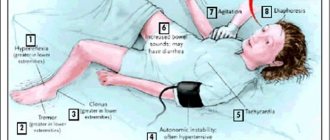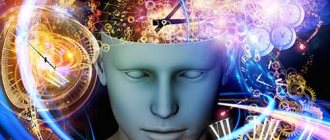Lecture “Human Psyche. Functions of the psyche"
PSYCHE
Plan:
- The concept of the psyche
- Functions of the psyche
- Disturbance of Consciousness
Literature:
- Vygotsky L.S. Psychology. –M.: Publishing house EKSMO-Press, 2010.
- Danilova N.N., Krylova A.L. Physiology of higher nervous activity: textbook. University with a degree in Psychology. –M.: Moscow State University Publishing House, 2009.
- Leontyev A.N. Selected psychological works: In 2 volumes. T.2. /Ed. V.V. Davydova et al. – M.: Pedagogy, 2008.
- Maklakov A.G. General psychology. – St. Petersburg, 2008.
1. The concept of the psyche. Functions of the psyche.
We feel tastes, smells, see objects, experience emotions. Some of us have an absolute ear for music, others have a good memory; Some enjoy walking, others enjoy reading books. Why can we experience and feel something, why are we so different from each other? Something gives us all these opportunities. This is our psyche. It is the properties and functions of the human psyche that provide us with everything we see, hear, feel, and how we behave.
The psyche is given to a person from birth, but develops in the process of life. It develops depending on the experience gained and circumstances. We need the psyche to receive, combine, understand information about the world around us, compare it with our needs and develop the necessary behavior. The basic functions of the psyche provide a person with adaptation to different conditions, the ability to communicate, learn, and, if the need arises, to survive. All functions are closely related and interdependent, therefore the normal psyche is holistic, they ensure the interaction of a person with the environment.
Psyche is a reflection of reality by the brain, manifesting itself in a person in the form of mental phenomena.
All mental phenomena are divided into three groups:
1) mental processes;
2) mental states;
3) mental properties of the individual.
Mental processes
are divided into:
1) cognitive (sensation, perception, thinking, memory and imagination);
2) emotional;
3) strong-willed.
Mental conditions
are divided into: 1)
motivational
- desires, interests, drives, passions;
2) states of organized consciousness
(manifested in various levels of attentiveness and efficiency);
3) emotional
(emotional tone of sensations, emotional response to reality, mood, conflicting emotional states - stress, affect, frustration);
4) volitional
(states of initiative, purposefulness, determination, perseverance, etc.
Borderline mental states of personality also differ
– psychopathy, character accentuations, neuroses and states of delayed mental development.
Mental states can be short-term, situational and stable, personal.
To psychic properties
personalities include:
1) temperament;
2) personality orientation (needs, interests, worldview, ideals);
3) character;
4) abilities.
This is the traditional classification of mental phenomena, coming from I. Kant. It underlies the construction of traditional psychology. However, this classification suffers from an artificial separation of mental processes from mental states and typological properties of the individual: cognitive, volitional and emotional processes are nothing more than certain mental capabilities (abilities) of the individual, and mental states are the current uniqueness of these capabilities.
2. Functions of the Psyche
- Communicative – provides the opportunity for people to communicate with each other.
- Cognitive – allows a person to understand the outside world around him.
- The regulatory function ensures the regulation of all types of human activity (play, study, work), as well as all forms of his behavior.
Factors of mental development Factors of mental development
it is generally accepted:
- heredity (the ability of an organism to repeat similar types of metabolism and individual development over a number of generations);
- environment (the social, material and spiritual conditions of his existence surrounding a person);
- developmental activity (the active state of the body, manifests itself when the movement programmed by the body towards a certain goal requires overcoming environmental resistance).
There are different points of view regarding the origin of the psyche:
- Idealistic -
the mental (soul) in its origin is not connected with the body (the biological carrier of the soul) and has a divine origin; - Dualistic -
there are 2 principles: mental (ideal) and biological (material). These two principles develop in parallel and are to a certain extent connected with each other. - Materialistically,
the phenomenon of the psyche is due to the evolution of living nature, and its existence should be considered as a property of highly developed matter.
Vygotsky Lev Semyonovich (1896-1934) - Soviet psychologist, author of the work “THE HISTORY OF THE DEVELOPMENT OF HIGHER MENTAL FUNCTIONS.”
Vygotsky L.S. showed that humans have a special type of mental functions that are completely absent in animals. These higher mental functions constitute the highest level of the human psyche and are called consciousness. They are formed during social interactions.
Higher mental functions (voluntary memory, voluntary attention, logical thinking) are of a social nature.
- First conclusion
in the work of Vygotsky L.S. answers the question: “How do relationships with the environment differ between animals and humans?” and it sounds like this:
The environment acts on the animal, modifying it and forcing it to adapt to itself. Man acts on nature and modifies it.
2) Second conclusion
lies in the fact that
a person, having mastered nature, learned to master his own psyche, he acquired higher mental functions, expressed in forms of voluntary activity (only a person is able to force himself to remember the necessary material, to pay attention to something).
3) Third conclusion
lies in the fact that a person tries to master his behavior with the help of psychological tools. (Vygotsky L.S. called them signs).
Signs are
artificial means with the help of which primitive man was able to master his behavior, memory, etc.
The main conclusion of Vygotsky’s concept:
“Man is fundamentally different from animals in that he has mastered nature with the help of tools. This left an imprint on his psyche - he learned to master his own higher mental functions. To do this, he uses psychological tools (signs). The universal and most typical system of signs is speech.”
Four levels of development of the psyche of living organisms
1. Irritability is
a property that distinguishes living matter from dead matter.
Manifests itself in the forced activity of a living organism. The higher the level of development of the organism, the more complex the manifestation of its activity.
Plants have the primary form of irritability (for example: “tropism” - forced movement towards the light).
2. Sensitivity -
characterizes the general ability to sense.
A distinctive feature from irritability is that living organisms have the opportunity to respond not only to biological environmental factors, but also to biologically neutral ones. (Characteristic of more developed organisms: worms, mollusks - the ability to avoid harmful environmental influences).
3. The behavior of higher animals is
a complex set of reactions of a living organism to environmental influences.
The higher the level of development, the more complex his behavior. Learning ability.
4. Human consciousness is
the highest level of mental reflection and regulation, inherent only to humans.
Consciousness acts as a continuously changing set of sensory and mental images that directly appear before the subject in his inner world and anticipate his practical activity.
A person refracts all perceived information about the world around him through a system of ideas about himself and forms his behavior based on values, ideals and motivational attitudes.
Only humans have the highest level of mental consciousness!
CONSCIOUSNESS -
the highest level of mental reflection of reality, manifested by the individual’s ability to be aware of the environment, present and past times, make decisions and manage their behavior in accordance with the situation.
Conscious activity is one of the highest psychological functions. Without the participation of consciousness, it is impossible to imagine any completed complex action.
The disease can change self-awareness, in particular, disrupt the awareness of oneself as a patient or the understanding of oneself as a person, one’s “I”.
3. Impaired Consciousness
In clinical practice, two large groups
pronounced pathological states of consciousness:
- Darkness;
- Shutdown;
1) Clouding of consciousness
includes:
- Delirium-
violation of orientation in place, time and environment, provided that orientation in one’s own personality is maintained.
The appearance of abundant visual and auditory hallucinations, usually of a frightening nature, is typical. The visual image is often various zoopsies (rats, mice, snakes, etc.). These disorders are accompanied by psychomotor agitation: the patient experiences fear, anxiety, tries to defend himself, and flee. The sympathetic nervous system is activated (increased blood pressure, sweating, trembling, tachycardia). In an acute condition, the patient poses a certain danger to others. After leaving the state, a partial memory of the experience is retained. Delirium is most often observed in alcoholism; in everyday life it is classified as “delirium tremens.”
- Amentia (amentive state
ie
) -
observed in severe and long-term illnesses (infections, septicopyemia, etc.).
Orientation in the environment, in time and in one’s own personality is disrupted. The patient does not comprehend his surroundings; his speech consists of fragments of phrases. Often the patient is agitated in bed. The painful condition can last for a long time.
- Oneirod
(dream-like state) - characterized by incomplete, often double, orientation in place, time and one’s own personality. The patient seems to be immersed in a world of dream-like fantastic dreams: he is on other planets, in exotic gardens, etc.
Moreover, he is not the main character, but rather an accomplice, in contrast to the state of delirium, in which the patient empathizes with vivid visual and auditory deceptions, and builds his behavior accordingly.
The facial expressions of patients are characteristic: sometimes they are detached and sad, sometimes they are “enchanted.” The eyes are often closed or half-closed. If you try to make contact with the patient, he can talk about his dreams and at the same time give his name and room number (double orientation). Memories of the experience remain. Patients talk colorfully about the most acute painful disorders. Oneiric disorders of consciousness are observed in acute endogenous psychoses and some infectious diseases.
- Cmoderate state
reminiscent of the state of a person at twilight, when he sees only a small number of dimly lit surrounding objects.
In such states, consciousness seems to slide, attention stops only on individual phenomena. The patient is well oriented in the environment, his self-awareness is changed. Behavior is dominated by automated actions that are outwardly quite orderly. The patient gives the impression of a person deeply immersed in his thoughts and fenced off from his surroundings. Sometimes frightening hallucinatory delusional states develop: the patient runs in fear or attacks imaginary enemies. In such cases, he is dangerous to others.
The twilight state is observed in epilepsy and organic diseases of the brain. The twilight state occurs suddenly and can also end unexpectedly. It usually lasts from several minutes to several hours, less often days. The memory of the experience is not retained.
- State of ambulatory automaticity
also characterized by automated forms of behavior. Awareness of the environment and self-awareness are altered (as in half-asleep). This includes sleepwalking (somnambulism, sleepwalking) and trance - a violation of consciousness, in which the patient can perform purposeful actions, travel by transport during the day, go to another area
The state of ambulatory automatism ends as suddenly as it appeared. If, upon leaving it, the patient finds himself in an unfamiliar environment, then he cannot give himself an account of what happened.
- Disorder of self-consciousness, and
Or
depersonalization is
a painful feeling of alienation of one’s own personality, conscious and painfully experienced by the patient himself.
The body has changed (it has become large, small, heavy, light) and its usual layout (long arms, short torso, excessively large head, etc.)
In the clinic of internal diseases, loss of consciousness is predominantly encountered (from mild to complete).
2)
Switching off consciousness
includes:
- Nullification
(from Lat. pubes - cloud) - mild impairment of consciousness.
Consciousness becomes foggy for a few seconds or minutes, covered with a light cloud. Orientation in the environment and one’s own personality is not disturbed, memories of events after a painful disorder are preserved.
- Somnolence
(drowsiness) - a long-term (hours, days) state resembling drowsiness.
The orientation is not affected. More often this occurs against the background of neurotropic intoxication (poisoning with alcohol, sleeping pills, etc.).
Based on the depth of disturbance of consciousness, coma, stupor and stupor are distinguished.
.
- Stun
- a state of incomplete wakefulness, which is characterized by loss or disturbance of varying degrees of severity of the coherence of thoughts and actions, due to a severe disorder of attention, drowsiness. Patients are lethargic, inhibited, and do not immediately respond to questions addressed to them; intelligence is reduced, memory is weakened.
Stunning occurs in varying degrees of severity and is observed in diabetic hyperglycemia, lobar pneumonia, peritonitis, neuroinfections, anemia, typhus, etc.
- Sopor
(Latin “unconsciousness”) - a deep stage of stunning.
The patient is immobilized, it is not possible to evoke responses from him, with the exception of pain (withdrawal of the hand when painful stimulation is applied to it), and the reaction of the pupils to light. The response to speech is either weak or absent. After a short awakening (with mild stupor), the patient again falls into an unconscious state and does not remember the moments of awakening in the future. This condition is observed in severe infections, intoxications, and severe cardiovascular decompensation.
- Coma-
a state of complete loss of consciousness.
The patient has no reactions to stimuli (speech, pain). There is no sleep-wake cycle. Eyes closed. It is observed with further aggravation of the above conditions, as well as with severe traumatic brain injury.
- Fainting -
sudden loss of consciousness caused by short-term anemia of the brain (due to spasm of cerebral vessels).
Coma and fainting differ from each other not only in external clinical manifestations, but also in the reasons that caused them and the nature of the course.
In coma and deep stupor, in addition to impaired consciousness, other symptoms are observed:
- Disruption of the normal breathing rhythm ; in severe cases, breathing becomes chaotic, and depressed breathing may even be observed;
- Impaired reaction of the pupils to light
(impaired eye movements, observed when lifting the eyelids or floating movements, fixation of gaze).
Causes of impaired consciousness:
- Neurological (stroke, status epilepticus, brain tumors, head injury, etc.);
- Metabolic (diabetes mellitus, hypothyroidism, adrenal insufficiency, liver failure, etc.);
- Hypoxia (asphyxia, severe heart failure);
- Sun or heat stroke;
- Poisoning.
Features of male psychology
Men are more concentrated, but the concentration time is very short, which is why representatives of the stronger sex, who have a clear goal in life, are so energetic and always achieve their goals. Their attention is not scattered on other goals.
At the same time, it is much more difficult for men to withstand prolonged physical and psychological stress. Men's thoughts have a clear direction. They find it difficult to switch from one topic to another. If men talk about cars, then another topic of conversation will be opened only after this one has completely exhausted itself.
Scientific interpretation
The concept of scientists on the issue of the emergence of the psyche is as follows:
- According to scientists, the psyche appeared at a certain stage in the development of living organisms. It is a reflection of their manners, habits and actions. As living beings progressed, the psyche also developed. In its evolution, it went through two stages: instinctive and personal training.
- Psyche and consciousness are the culminating phase of evolution. This achievement arose thanks to active work, which took place in a society that was quite civilized for that time.
- The psyche in action has the strongest development. It is movement and activity that creates change. An important pattern is the transition of activity and any actions into a mental image, and vice versa.
- The human psyche is shaped by the functioning of the brain, but in fact it is an individual phenomenon that depends on social actions.
- Mental phenomena have a specific system and structural organization.
LEADING ACTIVITY – GAME
So, play plays a major role in the mental development of preschool children. Going through certain age stages, it transforms depending on the degree of development of the baby:
- 3 – 4 years – director’s play;
- 4 – 5 years – the game becomes figurative and role-playing;
- 5 – 6 years – the game takes on a role-playing orientation;
- 6 - 7 years old - preschoolers play according to the rules established for each game.
Each game, to one degree or another, reflects some area of activity, as well as relationships. The game gradually ceases to be manipulative - using only objects. Its essence is transferred to a person, to his activities. Therefore, the child perceives the actions of adults as not only an objective, but also a subjective example.
The game has enormous developmental and educational significance. During games, children learn to fully communicate with each other: share, negotiate, help, conflict. The game develops motivation and the needs of children. In role-playing games with complex plots and actions, preschoolers actively develop their creative imagination. The game helps the child improve voluntary memory, perception, thinking, and intellectual activity. All this contributes to its further development and becomes the basis for preparation for training.
FORMATION OF PERSONALITY
One of the important aspects in the psychology of preschool age is the process of development of a small personality: its emotions, motivation, self-awareness.
- Emotional sphere.
The period of preschool childhood is relatively stable and calm emotionally: there are practically no special outbursts or conflicts, with the exception of the crisis of 3 years, when the child just realizes himself as a small social person. The stable development of the emotional sphere is facilitated by the development of the child’s ideas. Representations allow him to switch from a specific situation, so the difficulties that arise do not seem so significant. However, the experiences themselves gradually become more complex, deeper, more diverse, and the range of experienced emotions increases. For example, empathy for others appears. The child learns to feel and understand not only his own self. All images in the child’s mind acquire an emotional coloring, all his activities (and this, first of all, play) are saturated with vivid emotions.
- Motivation.
The beginning of personality formation is associated with the formation of such an important personal mechanism as the subordination of motives. They have different significance for a preschooler. One can distinguish motives of self-esteem (competition, achieving success), motives associated with the formation of moral standards, etc. In the preschool years, the child’s individual motivational system begins to build, which will be of great importance for his future success.
- Self-awareness.
It is considered to be the main new formation of the period. The formation of self-awareness is facilitated by active personal and intellectual development. Self-esteem is formed in middle preschool age, initially from one’s own assessment (necessarily positive), and then from assessments of the behavior of others. What is typical: the baby learns to evaluate the actions, skills or behavior of other children first, and then his own.
At this stage, gender identification occurs. Children recognize themselves as representatives of the male or female gender - a girl or a boy, and learn the features of appearance, clothing, character, behavior, and social roles of different sexes. By the senior preschool period, the child begins to perceive himself in time: he remembers what he was like in the past, is aware of himself “here and now,” and can also imagine what he will be like in the future. The baby knows how to correctly express these ideas in speech.
Features of female psychology
Concentration in women is poorly developed, but representatives of the fairer sex are able to quickly switch attention. She was just talking with a friend about what type of coffee is better, and then she jumps to where it is better to buy a handbag. Women can talk on several topics at the same time and understand each other perfectly. But a woman’s brain is constantly fixated on little things that can get in the way.
Women are able to withstand psychological stress for a long time, but if they do not give it an outlet, a breakdown will occur. Therefore, representatives of the fairer sex need relaxation and a shift of attention to unimportant little things.









